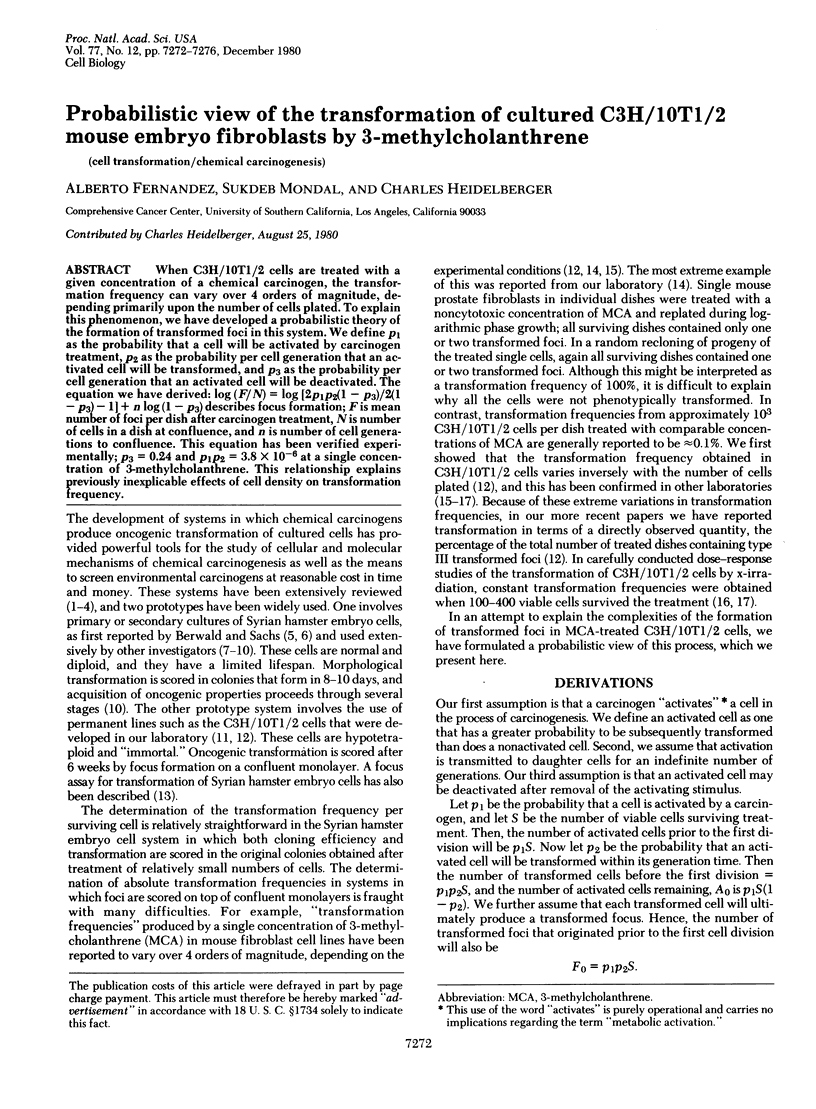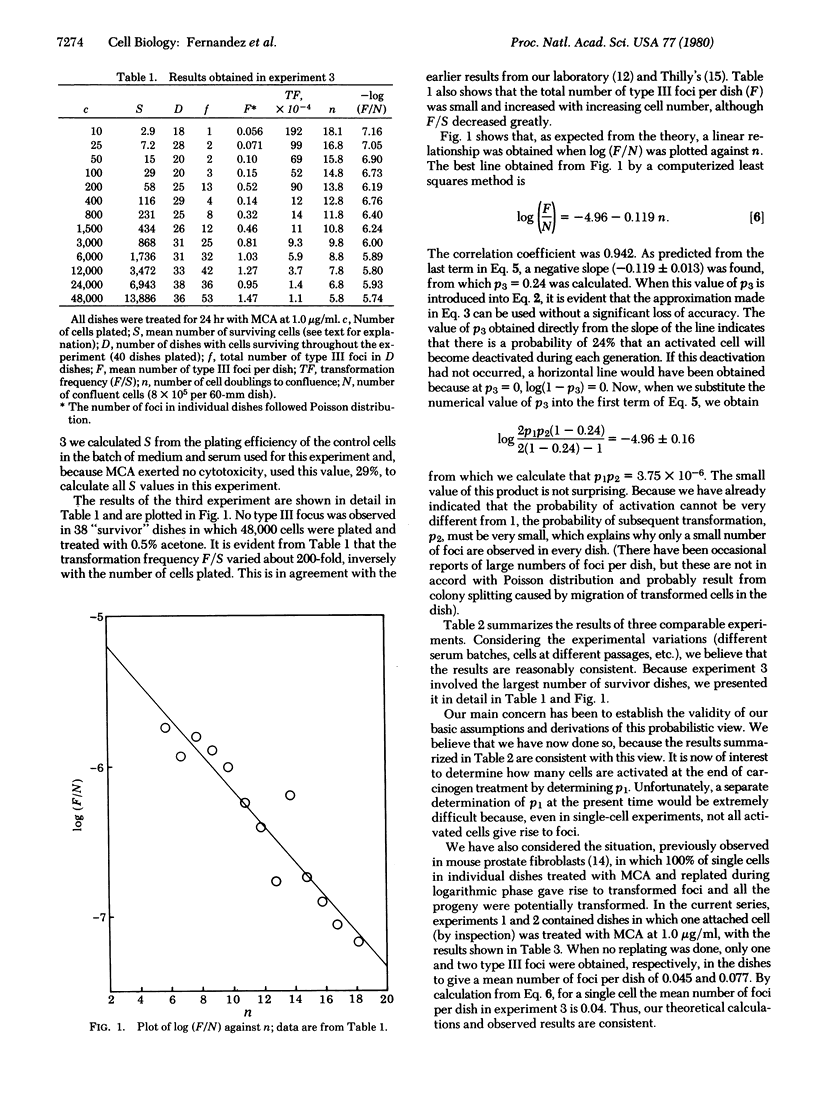Abstract
When C3H/10T1/2 cells are treated with a given concentration of a chemical carcinogen, the transformation frequency can vary over 4 orders of magnitude, depending primarily upon the number of cells plated. To explain this phenomenon, we have developed a probabilistic theory of the formation of transformed foci in this system. We define p1 as the probability that a cell will be activated by carcinogen treatment, p2 as the probability per cell generation that an activated cell will be transformed, and p3 as the probability per cell generation that an activated cell will be deactivated. The equation we have derived: log (F/N) = log [2p1p2(1 -- p3)/2(1 -- p3) -- 1]+ n log (1 -- p3) describes focus formation; F is mean number of loci per dish after carcinogen treatment, N is number of cells in a dish at confluence, and n is number of cell generations to confluence. This equation has been verified experimentally; p3 = 0.24 and p1p2 = 3.8 X 10(-6) at a single concentration of 3-methylcholanthrene. This relationship explains previously inexplicable effects of cell density on transformation frequency.
Full text
PDF




Selected References
These references are in PubMed. This may not be the complete list of references from this article.
- BERWALD Y., SACHS L. IN VITRO CELL TRANSFORMATION WITH CHEMICAL CARCINOGENS. Nature. 1963 Dec 21;200:1182–1184. doi: 10.1038/2001182a0. [DOI] [PubMed] [Google Scholar]
- Barrett J. C., Ts'o P. O. Evidence for the progressive nature of neoplastic transformation in vitro. Proc Natl Acad Sci U S A. 1978 Aug;75(8):3761–3765. doi: 10.1073/pnas.75.8.3761. [DOI] [PMC free article] [PubMed] [Google Scholar]
- Berwald Y., Sachs L. In vitro transformation of normal cells to tumor cells by carcinogenic hydrocarbons. J Natl Cancer Inst. 1965 Oct;35(4):641–661. [PubMed] [Google Scholar]
- Casto B. C., DiPaolo J. A. Virus, chemicals and cancer. Prog Med Virol. 1973;16:1–47. [PubMed] [Google Scholar]
- Casto B. C., Janosko N., DiPaolo J. A. Development of a focus assay model for transformation of hamster cells in vitro by chemical carcinogens. Cancer Res. 1977 Oct;37(10):3508–3515. [PubMed] [Google Scholar]
- DiPaolo J. A., Donovan P., Nelson R. Quantitative studies of in vitro transformation by chemical carcinogens. J Natl Cancer Inst. 1969 May;42(5):867–874. [PubMed] [Google Scholar]
- DiPaolo J. A., Nelson R. L., Donovan P. J. In vitro transformation of Syrian hamster embryo cells by diverse chemical carcinogens. Nature. 1972 Feb 4;235(5336):278–280. doi: 10.1038/235278a0. [DOI] [PubMed] [Google Scholar]
- Freeman A. E., Igel H. J., Price P. J. I. In vitrol transformation of rat embryo cells: correlations with the known tumorigenic activities of chemicals in rodents. In Vitro. 1975 Mar-Apr;11(2):107–116. doi: 10.1007/BF02624083. [DOI] [PubMed] [Google Scholar]
- Gehly E. B., Fahl W. E., Jefcoate C. R., Heidelberger C. The metabolism of benzo(alpha)pyrene by cytochrome P-450 in transformable and nontransformable C3H mouse fibroblasts. J Biol Chem. 1979 Jun 25;254(12):5041–5048. [PubMed] [Google Scholar]
- Haber D. A., Fox D. A., Dynan W. S., Thilly W. G. Cell density dependence of focus formation in the C3H/10T1/2 transformation assay. Cancer Res. 1977 Jun;37(6):1644–1648. [PubMed] [Google Scholar]
- Han A., Elkind M. M. Transformation of mouse C3H/10T1/2 cells by single and fractionated doses of X-rays and fission-spectrum neutrons. Cancer Res. 1979 Jan;39(1):123–130. [PubMed] [Google Scholar]
- Heidelberger C. Chemical carcinogenesis. Annu Rev Biochem. 1975;44:79–121. doi: 10.1146/annurev.bi.44.070175.000455. [DOI] [PubMed] [Google Scholar]
- Heidelberger C. Chemical oncogenesis in culture. Adv Cancer Res. 1973;18:317–366. doi: 10.1016/s0065-230x(08)60756-3. [DOI] [PubMed] [Google Scholar]
- Mondal S., Heidelberger C. In vitro malignant transformation by methylcholanthrene of the progeny of single cells derived from C3H mouse prostate. Proc Natl Acad Sci U S A. 1970 Jan;65(1):219–225. doi: 10.1073/pnas.65.1.219. [DOI] [PMC free article] [PubMed] [Google Scholar]
- Nesnow S., Heidelberger C. The effect of modifiers of microsomal enzymes on chemical oncogenesis in cultures of C3H mouse cell lines. Cancer Res. 1976 May;36(5):1801–1808. [PubMed] [Google Scholar]
- Pienta R. J., Poiley J. A., Lebherz W. B., 3rd Morphological transformation of early passage golden Syrian hamster embryo cells derived from cryopreserved primary cultures as a reliable in vitro bioassay for identifying diverse carcinogens. Int J Cancer. 1977 May 15;19(5):642–655. doi: 10.1002/ijc.2910190508. [DOI] [PubMed] [Google Scholar]
- Reznikoff C. A., Bertram J. S., Brankow D. W., Heidelberger C. Quantitative and qualitative studies of chemical transformation of cloned C3H mouse embryo cells sensitive to postconfluence inhibition of cell division. Cancer Res. 1973 Dec;33(12):3239–3249. [PubMed] [Google Scholar]
- Reznikoff C. A., Brankow D. W., Heidelberger C. Establishment and characterization of a cloned line of C3H mouse embryo cells sensitive to postconfluence inhibition of division. Cancer Res. 1973 Dec;33(12):3231–3238. [PubMed] [Google Scholar]
- Terzaghi M., Little J. B. X-radiation-induced transformation in a C3H mouse embryo-derived cell line. Cancer Res. 1976 Apr;36(4):1367–1374. [PubMed] [Google Scholar]


